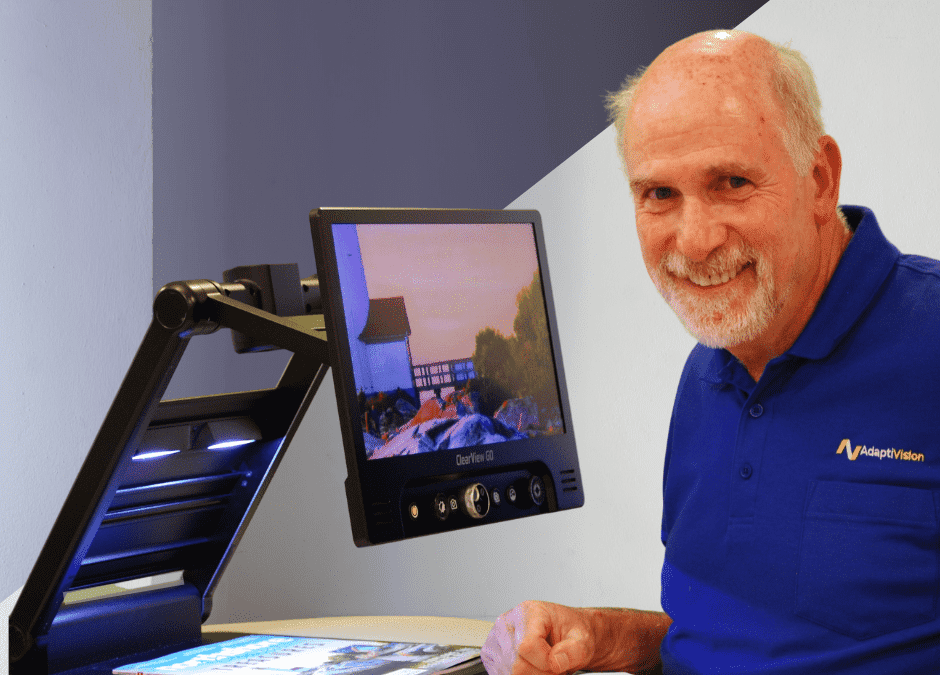Our last interview in this series featured Bernie McGee, who discussed how assistive technology has helped him build a successful career in the building and construction trade.
We are now “turning the tables” and chatting with our founder and president, Stu Flom, about why AT matters to him. Read on for our Q&A session with Stu, where he covers a range of issues including trends in assistive technology, the high cost of high tech, and the most important factors to consider when choosing a device.
Our Q&A with Stu Flom
Q: How long have you been in assistive technology sales?
A: 27 years.
Q: What is challenging about selling assistive technology?
A: As vision loss progresses, there is often a need to transition from low tech to high tech, with the accompanying learning curve. This can be a big adjustment for some folks, who are accustomed to simply visiting the eye doctor for a new eyeglass prescription.
When glasses aren’t enough anymore, it’s a matter of learning acceptance and openness: acceptance of the reality of the vision loss and a growing openness to new technology. Sometimes, my job entails coaching people in this process. It’s also important for me to provide mutually agreeable solutions for the client’s needs as well as adequate training.
On the other hand, there are instances when a person (or his/her family member) is really excited about a new technology but after an assessment, we come to an understanding that it is not the right solution for them. The solution always has to factor in the person’s goals, budget, remaining functional vision, and other environmental factors.
Aside from that, the end user must be intrinsically motivated to use assistive technology. Sometimes motivation is coming from others, such as a close family member.
Finances can be another challenge. Sometimes, a person who could truly benefit from a piece of technology simply cannot afford it. [Author’s note: state-based organizations, often referred to as the state’s Division for the Blind and Visually Impaired, have many programs and opportunities for those seeking support in living with low vision. For more information, please visit our State Resource pages.]
Stu Flom on Trends in AT
Q: How have you seen assistive technology change over the years?
A: I have seen huge changes in technology over the years. Back when I started in the “dinosaur age,” the only available low vision technology was large video magnifiers (CCTVs) with CRT tubes. They were big, bulky, heavy, and relatively expensive. Technology has become much more sophisticated over the years, especially with advancements in AI and OCR, which are integrated in many new devices. Device hardware has also become much smaller and much more portable. Wearable devices — which were nonexistent when I first started out — are also very prevalent now.
Today, there is also a much greater mainstream awareness of assistive technology than there was in the past, especially with the rise in demand for accessible design. A few years ago, Stevie Wonder was quoted as saying, “We need to make every single thing accessible to every person with a disability” during his remarks from the stage at the Grammys. Social media has played an important role in creating more awareness for assistive technology and the importance of accessibility in general.

Q: What trends do you see in assistive technology for the blind and low vision?
A: Devices are becoming smarter, more sophisticated, and smaller.
Important Considerations
Q: What is something people should focus on when researching and trying to find solutions for vision loss?
A: To find the right solution, it is critical to account for all relevant factors. Generally, important questions include:
– What are this person’s goals?
– Is this person willing and able to adapt to new technology?
– What is his/her remaining functional vision, if any?
– Does this person have restricted mobility?
– What environmental factors come into play? For example, is the person’s home large enough for the desired equipment? And what is his or her lighting set-up?


Share this image on your site:
What about the cost?
Q: Why does assistive technology tend to be expensive?
A: Because assistive technology is still not considered a mainstream consumer industry, the production volume for manufacturers is much less than for consumer devices, which drives up the cost.
Also, the environment is extremely competitive. A substantial investment must be dedicated to R&D, and the lifecycle of products is growing shorter with rapid advancements in technology and ever-increasing competition. When I first started out, there were only two major players in the market; now there are several.
At AdaptiVision, we are always seeking to find the best technologies to help our customers invest wisely in order to meet their goals.
Closing Thoughts
Q: What do you like most about your job?
A: Finding the right solution to meet a client’s needs is a huge blessing. I have the privilege of witnessing positive change and feeling that I have made a difference in a person’s life. I see students, people in vocational settings, and seniors becoming more independent and improving their quality of life. A person can return to work and succeed at their job because they have the right technology to support them.

Q: How did you end up in this field?
A: After working as a teacher in special education, I went to work for a high-tech lighting company. While there, I learned a lot about technology, but I really wanted to do more to help people directly. Working in assistive technology enables me to combine both skill sets in teaching and technology.
We hope you enjoyed getting to know Stu and the wisdom he shared through his many years of experience in the field. If you have other questions that we didn’t address here, just leave a comment and we’ll get back to you!
Author Information
By Stu Flom and Bethany Wyshak, with special thanks to Heather Allen at Vermont DBVI for providing interview questions.














